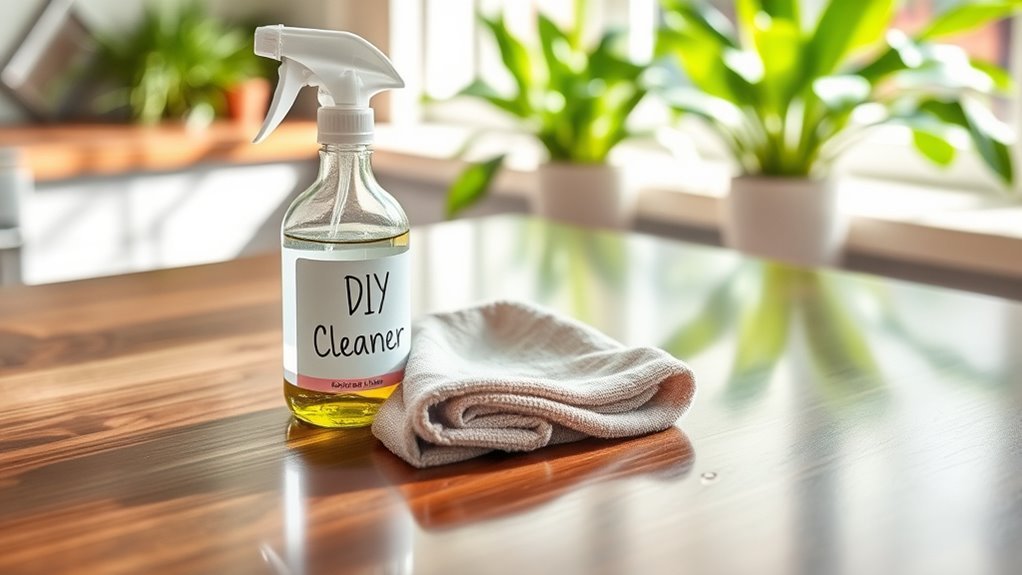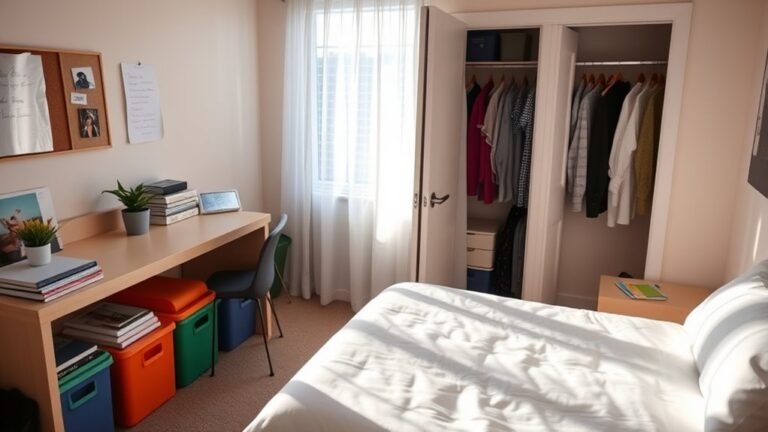DIY Cleaner for Laminate Surfaces
You can make a gentle, effective DIY cleaner for laminate surfaces using simple ingredients like white vinegar, water, and a bit of mild dish soap. This mix cuts grease and disinfects without harsh chemicals, keeping your floors and counters safe. Use a soft cloth to apply it sparingly, then dry immediately to avoid damage. Want tips on stain removal, proper techniques, and eco-friendly care that’ll keep your laminate looking great longer?
Benefits of Using a DIY Laminate Cleaner

While commercial cleaners can work, making your own DIY laminate cleaner lets you control the ingredients, ensuring it’s safe for your surfaces and your family. When you choose homemade solutions, you break free from harsh chemicals and unnecessary additives. Natural cleaners not only protect your laminate from damage but also reduce your carbon footprint, giving you peace of mind. You get to customize your cleaner to match your preferences—be it scent, strength, or ingredients—empowering you to maintain a healthy, toxin-free home. Plus, making your own cleaner is cost-effective and reduces waste from packaging. By embracing DIY laminate cleaners, you’re taking control, practicing sustainability, and enjoying the freedom to care for your home in a way that aligns with your values.
Essential Ingredients for Homemade Laminate Cleaners
When making your own laminate cleaner, it’s important to use safe household ingredients that won’t damage your surfaces. You’ll want to avoid harsh chemicals that can strip or dull the finish. Choosing gentle, natural items keeps your laminate looking great and your home healthier.
Safe Household Ingredients
Because laminate surfaces require gentle care, you’ll want to use safe household ingredients that clean effectively without causing damage. Baking soda uses include mild scrubbing to lift grime without scratching, while vinegar benefits come from its natural disinfecting and deodorizing properties. Combining these lets you enjoy a powerful yet gentle cleaner you control.
| Ingredient | Zweck |
|---|---|
| Baking Soda | Mild abrasive, deodorizer |
| White Vinegar | Disinfectant, grease cutter |
| Dish Soap | Cuts grease, gentle clean |
| Water | Dilutes, rinses residue |
These ingredients give you freedom from harsh chemicals, keeping your laminate surfaces spotless and safe. You can mix and match safely, knowing each component supports your goal: clean, damage-free laminate.
Avoiding Harmful Chemicals
Even if you’re tempted to reach for strong commercial cleaners, you’ll want to avoid harmful chemicals that can damage laminate surfaces over time. These chemicals may cause discoloration, dull finishes, or even peeling, robbing you of your laminate’s original look. Plus, chemical exposure isn’t just risky for your surfaces—it can also affect your health and indoor air quality. By steering clear of harsh ingredients like ammonia, bleach, or abrasive solvents, you protect both your laminate and yourself. Instead, choose simple, natural alternatives that clean effectively without those harmful effects. This way, you maintain the freedom to keep your space fresh and safe, all while preserving your laminate’s durability and appearance for years to come.
Step-by-Step Guide to Making Your Cleaner

Creating your own laminate surface cleaner is simpler than you might think. You’ll need just a few ingredients and basic cleaning tools to guarantee surface protection without harsh chemicals. Here’s a quick guide to get you started:
| Ingredient | Amount |
|---|---|
| White vinegar | 1 cup |
| Water | 1 cup |
| Mild dish soap | 1 teaspoon |
Mix the vinegar and water in a spray bottle, then add the dish soap. Shake gently to combine. This DIY cleaner is gentle yet effective, giving you the freedom to clean confidently without risking damage. Using your own cleaner means you control what touches your laminate surfaces, making it easier to protect and maintain their finish. Grab a soft cloth or sponge, and you’re ready to go!
Proper Techniques for Cleaning Laminate Surfaces
Once you have your DIY cleaner ready, knowing how to apply it properly will help keep your laminate surfaces looking their best. Start by using a soft cloth or microfiber mop to gently wipe down the area, avoiding harsh scrubbing that could damage the finish. Apply your cleaner sparingly—too much liquid can seep into seams and cause swelling. Focus on spot cleaning stubborn stains with a careful, circular motion. Always work in the direction of the laminate’s grain to maintain its natural look. After cleaning, dry the surface immediately to prevent water damage. These cleaning techniques aren’t just about appearance—they’re key to surface protection, extending your laminate’s life while giving you the freedom to keep your space fresh without worry.
Tips for Maintaining Laminate Flooring and Countertops

Although laminate surfaces are durable, regular maintenance is essential to keep your flooring and countertops looking great and lasting longer. Sticking to simple maintenance routines and using the right cleaning tools lets you enjoy freedom from constant worry about wear and stains. Avoid excess water and harsh chemicals to preserve the finish.
| Task | Recommended Tools | Frequency |
|---|---|---|
| Daily Dusting | Microfiber cloth | Daily |
| Spill Cleanup | Soft sponge, mild soap | Immediately |
| Deep Cleaning | Laminate cleaner, mop | Weekly |
Common Mistakes to Avoid When Cleaning Laminate
When cleaning laminate surfaces, you’ll want to steer clear of common mistakes that can damage the finish or shorten their lifespan. One big error is overdoing the cleaning frequency; too much moisture or harsh scrubbing wears down the protective layer. Stick to a regular but moderate schedule that fits your lifestyle. Also, avoid using abrasive cleaning tools like steel wool or rough brushes—they can scratch and dull the surface. Instead, choose soft cloths or microfiber mops that gently lift dirt without harm. Another pitfall is using harsh chemicals or bleach, which break down the laminate’s seal. By selecting the right cleaning tools and maintaining a balanced cleaning frequency, you’ll keep your laminate looking fresh and extend its freedom to shine for years.
How to Remove Stubborn Stains on Laminate
Even with the right cleaning routine, some stains on laminate surfaces can be tough to lift. When tackling stubborn marks, start with gentle stain removal by applying a mixture of baking soda and water to create a paste. Gently rub this on the stain using a soft cloth or sponge—avoid scrubbing hard to protect the surface. For tougher spots, try a small amount of rubbing alcohol on a cloth, but always test in an inconspicuous area first. These cleaning techniques let you regain control without harsh chemicals, keeping your laminate looking fresh and free. Remember, patience and care are key—you can handle those stubborn stains and maintain your laminate’s sleek look while enjoying the freedom of DIY cleaning.
Eco-Friendly Alternatives for Laminate Surface Care
If you want to keep your laminate surfaces clean without harming the environment, there are plenty of eco-friendly alternatives you can try. Opt for natural cleaning solutions like a mix of water and white vinegar or a few drops of castile soap. These ingredients are gentle yet effective, cutting through grime without harsh chemicals. Not only do these options reduce your environmental impact, but they also help maintain your freedom from toxic fumes. You can easily make your own cleaner, giving you control over what touches your home. Plus, natural cleaning products are biodegradable, so they won’t pollute waterways or harm wildlife. Embracing these eco-friendly methods lets you care for your laminate surfaces responsibly while staying true to your values.
Häufig gestellte Fragen
Can DIY Cleaners Damage Laminate Surfaces Over Time?
You might worry that using certain cleaners could harm your laminate durability concerns over time, and that’s a valid point. Some cleaner ingredient effects, like harsh chemicals or abrasive materials, can wear down the surface, dulling the finish or causing damage. To keep your laminate looking great and maintain its freedom from damage, you should pick gentle, pH-balanced solutions and avoid anything too acidic or abrasive. That way, you’re protecting your investment while enjoying easy maintenance.
How Often Should I Clean Laminate Surfaces With DIY Solutions?
They say, “A stitch in time saves nine,” and that’s true for your cleaning frequency. You don’t want to let dirt build up on laminate surfaces, so aim to clean them once a week with gentle DIY solutions. For maintenance tips, avoid soaking the surface and always use a soft cloth. This way, you keep your space fresh and free, without risking damage or losing that effortless glow you love.
Are DIY Laminate Cleaners Safe for Pets and Children?
You’ll want to choose pet safe ingredients and child friendly formulas to keep your home worry-free. Many DIY cleaners use natural elements like vinegar, baking soda, and lemon juice, which are generally safe around pets and kids. Just avoid harsh chemicals or essential oils that can be harmful. Always test in a small area first and keep your little ones and furry friends away while cleaning to maintain a safe, fresh environment.
Can I Store Homemade Laminate Cleaner for Long Periods?
Keeping your homemade cleaner is like preserving a secret recipe—timing is everything. You can store it for a few weeks, but remember the ingredient shelf life; natural elements like vinegar or essential oils may lose potency. For storage tips, keep it in a cool, dark spot in a sealed container to maintain freshness. This way, you stay free from frequent mixing while ensuring your cleaner works effectively when you need it.
What Should I Do if Laminate Surfaces Become Sticky After Cleaning?
If your laminate surfaces become sticky after cleaning, it’s likely due to leftover sticky residue from your cleaner. You should try wiping the area with a damp cloth soaked in warm water to remove any build-up. Avoid harsh chemicals or excessive scrubbing, which can damage the surface. Using gentle cleaning techniques, like a mild soap solution, can help restore that smooth finish and keep your space feeling fresh and free.






